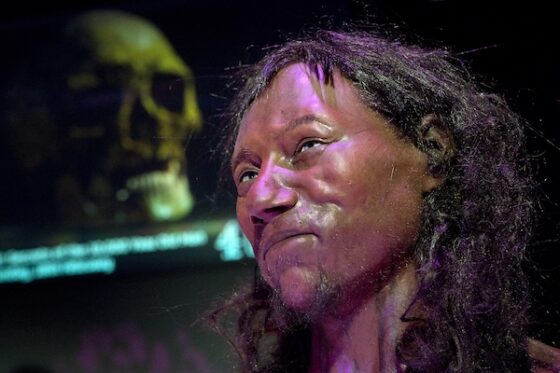Early Dutch were dark-skinned and blue-eyed, dna research shows


The theory suggests the hunter gatherer population living in the area called Doggerland some 10,000 years ago gradually became whiter as agriculture replaced the hunt for aurochs and deer as a main food source, and other peoples from the Eurasian steppes made their way to the low lands.
One theory proposed by scientists is that a lighter, more sun-absorbent skin developed as a reaction to the lack of vitamin D in the grain-based diet.
The data about the early Dutch, based on the dna of eight pieces of human bone picked up off the Dutch coast by volunteers and found in fishermen’s nets, form part of a huge genetic atlas charting the movements of hunter gatherers in Europe in the last 35,000 years.
Five years ago, for example, dna analysis of a 10,000 year-old skeleton found in a cave in western England showed the first Britons were black.
‘Our ancestors are always have always been portrayed as these butch white types. But that is not what they looked like at all,’ archaeologist and geneticist Eveline Altena told the Volkskrant.
Exhibition
‘The earliest inhabitants of this country were dark-skinned and blue-eyed,’ Luc Amkreutz, curator of the pre-history department at Leiden museum Rijksmuseum van Oudheden, concurred.
A recent exhibition at the museum also showed the Doggerland people to be black and genetic studies on bones from Denmark, Luxembourg and Norway also showed black ancestry.
‘But this the first time it has been genetically proven, important, because it puts paid to the popular perception that the early Europeans were white,’ Amkreutz said.
Geneticist Altena said bone fragments of early Dutch people continue to be found by volunteers each month. Altena, who works at the Harvard Medical School in Boston, now has some 200 fossils for further research.
‘It shows the importance of citizen science,’ she said. ‘The next step is to zoom into more regional developments. How big were the groups of people living together, for instance, and how were they composed? That is what we are currently finding out,’ she said.
Thank you for donating to DutchNews.nl.
We could not provide the Dutch News service, and keep it free of charge, without the generous support of our readers. Your donations allow us to report on issues you tell us matter, and provide you with a summary of the most important Dutch news each day.
Make a donation